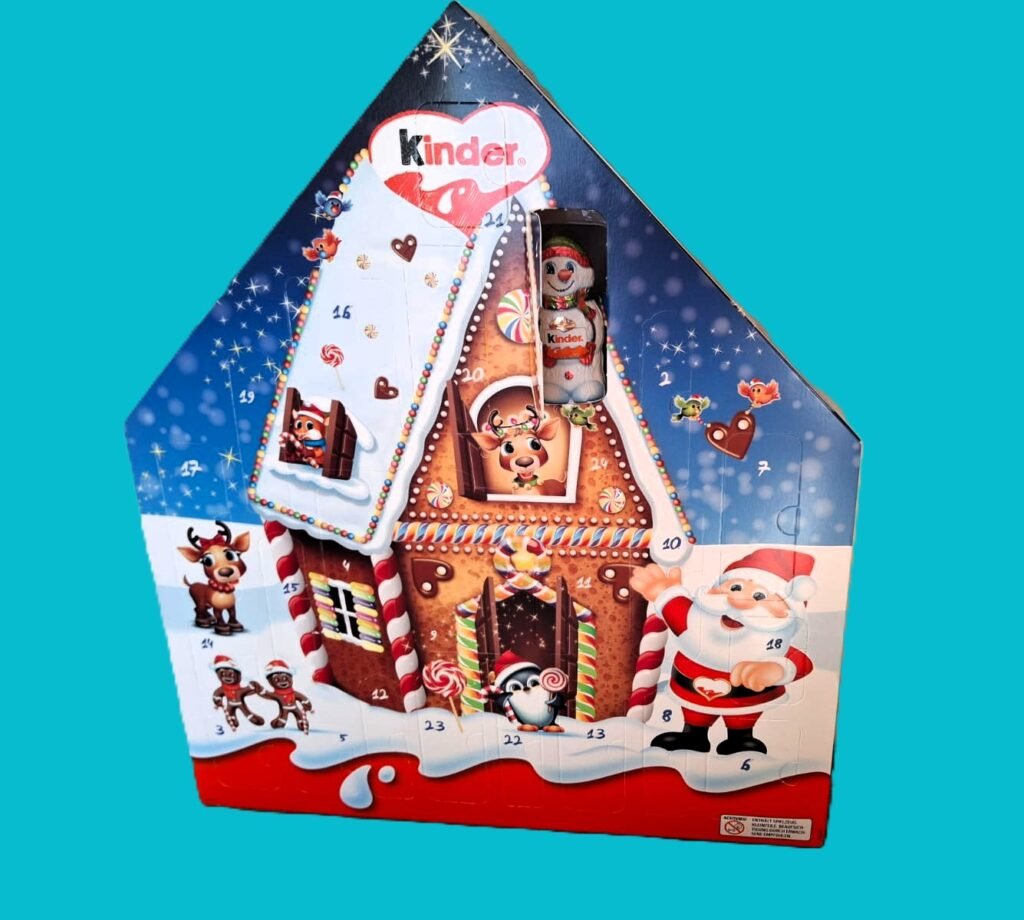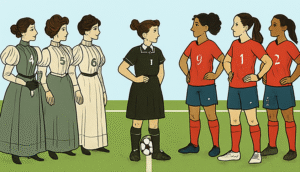December is a time to summarize the results of the outgoing year. Many people, along with anticipation of the coming holidays, feel anxiety caused by unfinished business, unfulfilled hopes, and bitter disappointments. The looming deadline drains vital energy. But you want to look fit, feel good, and rejoice with loved ones on New Year’s Eve.
There are many ways to recharge your life battery and bring back the holiday spirit you need. A good Christmas movie, heartfelt conversations with close friends, or delicious chocolate will help lift your spirits. A colorful advent calendar has become a popular remedy against negative emotions. This Christmas set can brighten your dull routine, bringing magic moments daily. Imagine you wake up in a bad mood, and nothing makes you happy. Then, you notice a bright cardboard box with 24 secret windows of happiness, and the negative aura completely disappears. Then, your hand carefully pulls a chocolate bar, lip gloss, or bath bomb from the compartment. Instantly, your face lights up with a sunny smile. It feels so good just knowing that there are 23 more surprises at hand.

Nowadays, the Advent calendar is more of a festive quest with pleasant gifts and puzzles, which, from the first Advent until Christmas, fills both children and adults with happiness. A bright box becomes a fascinating journey with a sweet aroma on the way to the main holiday. The Advent calendar not only entertains but also develops patience and endurance. The Advent calendar, with its religious origins, is deeply connected to the Advent celebration that first started in the fifth century. This celebration is a time of spiritual preparation for the bright Christian holiday of the year, the birth of Jesus. The Advent season begins for Catholics and Protestants on Sunday, four weeks before Christmas. It symbolizes the pre-Christmas period in the Christian tradition. The Advent calendar helps us keep a critical countdown to the coming of Christ and the bright holiday.
The Advent calendar’s lineage dates back to the late Middle Ages. Its prototype was an image of the Virgin Mary with the Child on the background of a tree with 24 branches, symbolizing the days left until the holiday.
Nowadays, Advent calendars can be bought in various shops. But centuries ago, people tried to find a way to brighten their wait for the year’s most significant holiday.
Some imaginative parents would draw 24 lines with chalk on a wall, board, or door, which their children would erase each evening. Others would divide a candle into 24 pieces and burn one piece every day. Some would add straws to a Christmas crib daily or hang pictures of holiday themes on the wall. Homemade Christmas trees on wooden stands were also popular. Each day, children would hang a small flag or star with verses from the Bible on the evergreen tree and light a candle.
In 1838, Johann Hinrich Wichern, a German theologian and founder of the Rauhes Haus orphanage in Hamburg, played a pivotal role in the evolution of the Advent calendar. He visually demonstrated to his pupils how many days remained until Christmas. He made the first Advent wreath from a cartwheel and candles, which he hung in the prayer hall. Johann Hinrich Wichern stuck 20 small red and four large white candles into it. On ordinary days, during prayers and Christmas carols, children lit one red candle and one white candle on each pre-Christmas Sunday. By the way, he was the first to come up with the idea of decorating a room for Christmas and using the traditional Christmas wreath of our time.
Who influenced the creation of the modern advent calendar? The first to be mentioned was an Austrian who owned a Protestant bookstore and, in 1851, made the first wooden Advent calendar, which depicted a religious event for each day until Christmas. In 1902, the Protestant bookstore Trümpler in Hamburg published the first printed calendar for children in the form of an Advent clock. The brass hand of the clock was turned one notch each day. The dial was printed with excerpts from famous Christmas carols or nativity scenes.
The Munich publisher Gerhard Lang created the Advent calendar, which resembles its modern version. He was inspired by unforgettable childhood memories of a pre-Christmas surprise his mother lovingly made for him.
The wife of a Protestant pastor from the small German town of Maulbronn drew 24 windows on cardboard. She sewed a tiny Wibele cookie inside each of them, thus turning the agonizing wait for her son into an exciting game. Gerhard Lang, the inventor of the printed Advent calendar, wanted this Christmas game to help all children anticipate joy. In 1904, the first commercial Advent calendar appeared, designed by German artist and illustrator Richard Kepler. The first Advent calendar was printed in Munich by Reichold& Lang. It was called “Im Lande des Christkinds” (In the Land of the Christ Child) and supplemented the Stuttgart newspaper. The first printed calendar did not have the opening windows we are accustomed to. It was made up of two sheets of cardboard. One part was a lithographic print containing windows with twenty-four cells. Inside each one were short poems written by Lang himself. The other part had 24 Christmas pictures. During Advent, children read poems daily, cut out pictures, and paste them into the designated window. The last image of the baby Jesus in a white robe was intended for Christmas Eve, December 24. Gerhard Lang’s project had a great commercial success. Later, he presented many interesting variations of his Advent calendars. In 1930, a version for the blind appeared, printed in Braille.
During World War II, the concept of an Advent calendar should have disappeared from humanity’s consciousness forever. The Nazi Party, in its quest for control, had banned the printing of colorful illustrated calendars, and paper became scarce. However, the Third Reich, not wanting to deprive its children of such a fun pastime, decided to modernize the Advent calendar to fit its ideology. The traditional Christian customs were suppressed, and religious symbols were erased. The calendar was now called “Vorweihnachtlichen” (pre-Christmas), featuring Nazi Christmas carols, images of tanks, weapons, and Nazi soldiers. The Nazis even renamed the Advent wreath itself into a Solar wreath and the Christ Child into the Child of Light. Fortunately, this transformation was short-lived. The colorful Advent calendars of old, good times returned with the war’s end.
Exhausted by the dark and devastating war period, people wanted to return to an everyday, calm life filled with joy and magic. The Advent calendar was revived at Christmas 1945, thanks to factories that were not destroyed and had paper stocks. The Stuttgart publisher Richard Sellmer restored the true pre-war fairy-tale spirit of the Advent calendar. In late winter 1945, he asked the American occupation authorities in Stuttgart for permission to print Advent calendars for sale in Germany. Sellmer received the coveted permit to purchase paper from the French zone on December 6, 1945. It seemed a great time to print 50000 copies of the first Sellmer Advent. Unfortunately, the miracle did not happen that year, as the holiday season ended. He had a year to create a three-section folding cardboard standing Advent calendar called “Die Kleine Stadt” (The Little Town) with graphic artist Elisabeth Lörcher. Finally, in 1946, the first batch of calendars was released, which had considerable success first in Germany and later in Great Britain and the USA. This was the first post-war calendar prepared for the international market.
The Golden Age of Advent calendars began in the 1950s. During this period, they became widespread and accessible to anyone. The calendars’ themes were simple, like romantic snow-covered cities and a Nativity scene hidden behind a 24-door. At the same time, exquisite hand-painted calendars were available.
The Sellmer company also introduced the Christmas Advent calendar to the American people. In December 1953, the National Epileptic League, an American charity that supports research into the treatment of epilepsy, ran a fundraising campaign by selling Sellmer Advent calendars made in Germany. The family of the 34th President of America, Dwight David Eisenhower, supported a charity fundraising campaign. In 1953, Newsweek magazine published a photograph of the president’s three young grandchildren happily posing with a Sellmer Advent calendar. In this way, Eisenhower supported his fellow countrymen since he had German roots on his father’s side. That Christmas photo started the American history of the Advent calendar. Many Americans wished to receive such a colorful gift. The family of Richard Nixon, who was then vice president, also promoted the Advent calendars. There is a photograph of Nixon’s wife, Patricia Nixon, looking at an Advent calendar with her young daughters Tricia and Julie in the mid-1950s. In addition to presidential advertising, American soldiers who recently returned from Germany brought home the German Advent calendars and promoted their popularity in the USA. Sellmer and other publishers created calendars with American-oriented designs to better appeal to American consumers, such as a fireplace with Santa.
The first chocolate Advent calendars appeared in 1950. Behind the mysterious window, children could find a Christmas picture and a delicious treat. The first commercial sweet Advent calendar appeared in 1971 when Cadbury began mass-producing calendars with little chocolate Santas inside. The lovely gifts featured a festive design.
Today, the wide variety of Advent calendars intended for different ages is mind-boggling, and that is a brilliant marketing move because, at heart, adults always remain little children. These gifts with cells are perfect for the whole family. And, of course, you can find a delicious gift with 24 windows for your beloved pet. Different brands offer Advent calendars for every taste, from sweets, cosmetics, and toys to jewelry or a beer calendar. Lovers of luxury items can buy the Tiffany Advent calendar, made in the form of the New York Flagship store.

Your eyes run wild from the abundance of calendars, and you don’t know which one to choose. Fortunately, bloggers` reviews on the YouTube channel help you navigate such a bright variety. You can also take a quick peek at the back of the Advent calendar set to see a gift summary. It is essential to have such tips to save yourself from unnecessary purchases and disappointment.
Last year, I bought a calendar from the cosmetic brand Ritual, which delighted me with body care products throughout pre-Christmas. This year, I wanted something different. I looked at various cosmetic brands but didn’t find any appropriate items. You should only buy a gift with cosmetics if the brand suits you and you will continue to use it. It is better to purchase calendars with sweets that will please everyone. This year, I chose a sweet Advent calendar from the Kinder brand. I’m delighted with my purchase. I got delicious sweets and even two chocolate eggs as a surprise.
You don’t have to buy an Advent calendar in a store; you can make it yourself, including presents and various puzzles. And it can bring magic and unforgettable moments for the whole family. You can create an Advent calendar that includes watching a new Christmas movie daily. For example, in Scandinavian countries, from December 1, residents watch the Advent series (Julekalender), which runs until Christmas. This format appeared on radio in 1957, and the first television premiere was in Sweden in 1960. Or you can join forces with all your neighbors and create a friendly interactive calendar. This format of a living Advent calendar took place in 2005 in Stockholm, where every day, a window was opened in one of the houses in the old town, and residents presented different performances. These could be songs, dances, carols, reading poems, or legends associated with Christmas.
An Advent calendar is a great way to lift your spirits and fill monotonous, gray days with fabulous moments.




